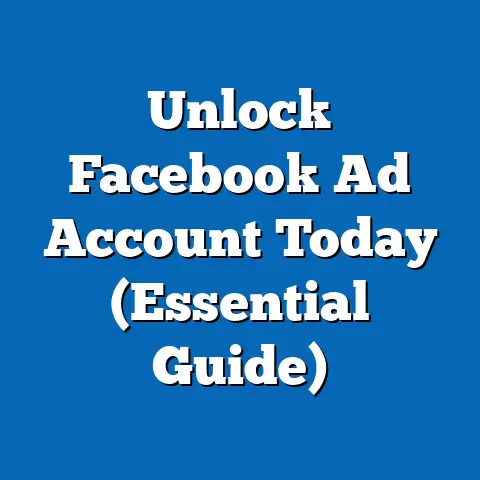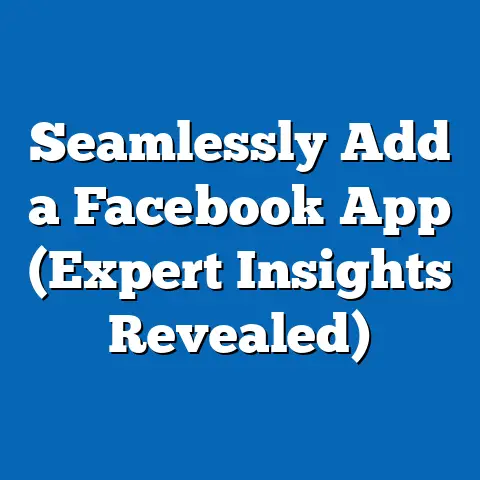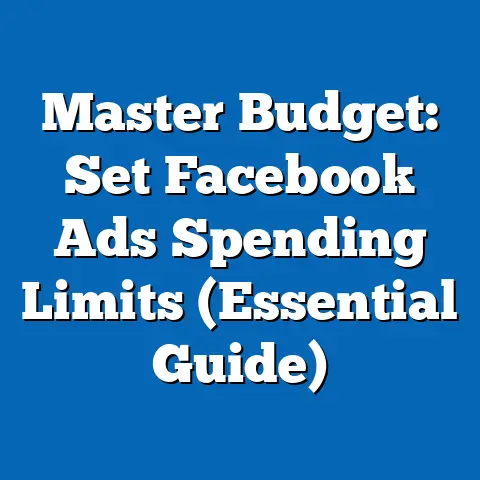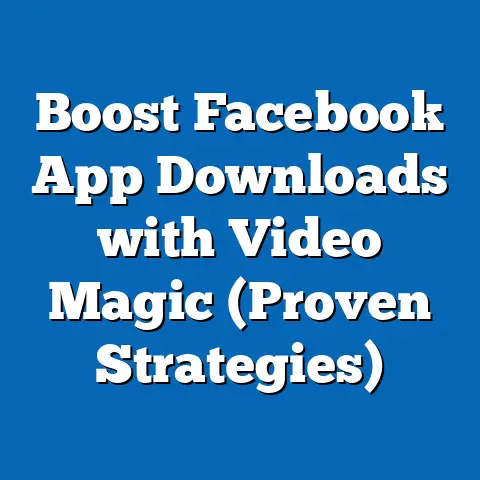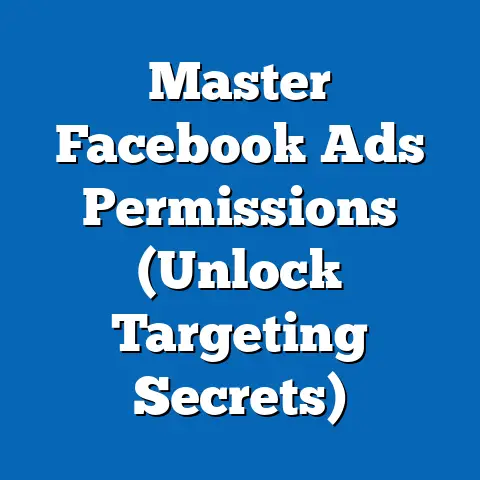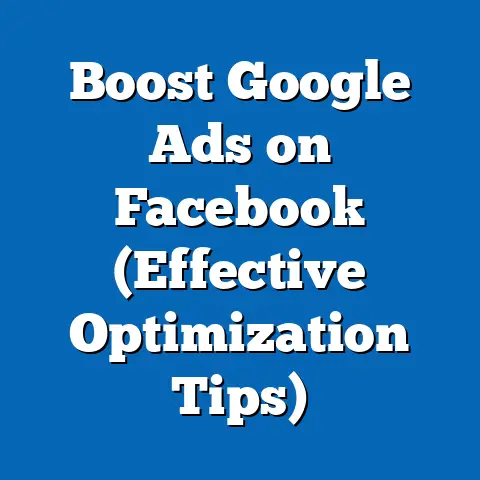Do I Really Need a Landing Page for Facebook Ads? (Must-Know Insight)
It’s a question I hear all the time: “Do I really need a landing page for my Facebook ads?” You’re pouring money into Facebook, crafting compelling ad copy, and targeting the perfect audience. But should you send them straight to your homepage, or take the extra step and create a dedicated landing page?
I get it. It feels like an extra layer of work. Another piece to design, another URL to track. But trust me, the answer is almost always a resounding yes. Let me tell you about Sarah, a local bakery owner I worked with a few years back. She was running Facebook ads promoting her new line of gluten-free cupcakes, directing traffic to her website’s homepage. She was getting clicks, but no sales. Frustrated, she almost pulled the plug on the entire campaign.
Then, we built a dedicated landing page showcasing only the gluten-free cupcakes, complete with mouthwatering photos, customer testimonials, and a clear call to action: “Order Your Gluten-Free Cupcakes Today!” The results? Conversions skyrocketed by 75%.
That’s the power of a well-crafted landing page. And that’s why I’m writing this article. I’m going to explore the crucial role landing pages play in Facebook advertising, and give you the insights you need to decide whether they’re essential for your campaigns. Because, while there are exceptions, understanding the difference a focused landing page can make could be the key to unlocking your Facebook ad success.
Let’s dive in and see if you really need a landing page for your Facebook ads.
The Basics of Facebook Ads
Before we get into the nitty-gritty of landing pages, let’s quickly recap Facebook ads. I’ve been working with Facebook’s advertising platform for over a decade, and it continues to be one of the most powerful tools for reaching a targeted audience.
Facebook ads are, simply put, advertisements displayed on the Facebook platform. They can appear in users’ news feeds, in the right-hand column, in Facebook Marketplace, in Facebook Stories, and even on Instagram (since Facebook owns Instagram). They come in various formats, including image ads, video ads, carousel ads (showing multiple images or videos), and collection ads (designed for e-commerce).
But what makes Facebook ads so effective? It’s their incredible targeting capabilities. I can target people based on demographics (age, gender, location), interests (hobbies, pages they like), behaviors (purchase history, online activity), and even custom audiences (people who have interacted with your website or app). This precision targeting allows me to reach the right people with the right message at the right time.
The objectives of Facebook advertising are diverse. They range from increasing brand awareness (getting your name out there), generating leads (collecting contact information from potential customers), driving website traffic (getting people to visit your site), boosting engagement (getting people to like, comment, and share your content), and, of course, driving conversions (making sales or achieving other specific goals).
Each of these objectives plays a role in the customer journey, that path a potential customer takes from initial awareness to final purchase. Think of it like this:
- Awareness: Someone sees your ad for the first time and becomes aware of your brand or product.
- Consideration: They click on your ad and start researching your offering.
- Decision: They decide whether or not to purchase your product or service.
- Action: They complete the purchase or take the desired action.
Facebook ads can be used at any stage of this journey. An awareness ad might simply show off your brand’s logo and mission. A conversion ad, on the other hand, is designed to get someone to buy something right now. And that’s where the question of landing pages really comes into play. The effectiveness of that conversion ad hinges on what happens after someone clicks. Are you sending them to a page that’s specifically designed to convert them, or are you leaving it to chance?
Key Takeaway: Facebook ads are a powerful tool for reaching a targeted audience and achieving a variety of marketing objectives. Understanding the customer journey is crucial for designing effective ad campaigns.
What is a Landing Page?
Now, let’s define what I mean by “landing page.” I’ve seen so many people confuse it with a regular website page, so let’s clear this up. A landing page is a standalone web page created specifically for a marketing or advertising campaign. It’s where a visitor “lands” after clicking on a link in an email, ad, or other marketing source.
The key difference between a landing page and a regular website page (like your homepage) is its focus. A landing page is designed to achieve a single, specific goal. That goal could be anything from collecting email addresses to selling a product to registering attendees for a webinar. Your homepage, on the other hand, has multiple goals – it’s trying to be everything to everyone.
Think of it this way: your homepage is like a general store, offering a wide variety of products and services. A landing page is like a specialty shop, focused on selling one specific item.
What are the key elements of an effective landing page? Here are a few that I always focus on:
- Clear Call-to-Action (CTA): This is the most important element. Your CTA should be prominent, easy to understand, and tell visitors exactly what you want them to do (e.g., “Download Now,” “Sign Up Today,” “Get a Free Quote”).
- Targeted Messaging: The messaging on your landing page should be directly relevant to the ad that brought the visitor there. If your ad promotes a discount on running shoes, your landing page should focus on running shoes and the discount.
- Minimal Distractions: Remove anything that could distract visitors from your CTA. This means eliminating unnecessary navigation, sidebars, and links to other parts of your website.
- Compelling Headline: Your headline should grab visitors’ attention and immediately communicate the value of your offer.
- Benefit-Oriented Copy: Focus on the benefits of your product or service, not just the features. Tell visitors how it will solve their problems or improve their lives.
- Trust Signals: Include elements that build trust, such as customer testimonials, reviews, security badges, and guarantees.
- Visual Appeal: Use high-quality images and videos to make your landing page visually appealing and engaging.
- Mobile Optimization: Ensure your landing page is responsive and looks good on all devices, especially mobile phones.
There are different types of landing pages, each designed for a specific purpose. Here are a few common examples:
- Lead Capture Pages: These pages are designed to collect contact information from potential customers. They typically include a form where visitors can enter their name, email address, and other details.
- Sales Pages: These pages are designed to sell a specific product or service. They often include product descriptions, pricing information, customer testimonials, and a “Buy Now” button.
- Thank-You Pages: These pages are displayed after a visitor completes a desired action, such as filling out a form or making a purchase. They typically include a thank-you message and instructions on what to do next.
- Click-Through Pages: These pages provide additional information about an offer and then direct visitors to another page to complete a purchase or sign-up.
- Webinar Registration Pages: These pages are used to collect sign-ups for webinars or online events.
I remember working on a Facebook ad campaign for a local yoga studio. Their initial ad directed traffic to their general class schedule page. We switched to a dedicated landing page highlighting a special “Beginner’s Yoga” package, complete with a video of the instructor and a limited-time discount. The result? A 3x increase in sign-ups.
That’s the power of focus. A landing page allows you to tailor your message, your visuals, and your call to action to a specific offer, increasing the likelihood that visitors will take the desired action.
Key Takeaway: A landing page is a standalone web page designed to achieve a single, specific goal. It’s different from a regular website page because it’s focused, targeted, and optimized for conversions.
The Case for Landing Pages in Facebook Ads
Now, let’s get to the heart of the matter: Why are landing pages so beneficial for Facebook ads? I’ve seen countless campaigns transformed by the simple addition of a well-designed landing page. Here’s why they work:
-
Increased Relevance: This is the big one. When someone clicks on your Facebook ad, they’re expecting to see something specific. If your ad promises a discount on winter coats, they want to land on a page that shows winter coats and the discount. A generic homepage simply won’t cut it. By creating a landing page that directly reflects the ad’s message, you increase the relevance of your offer and improve the user experience. This, in turn, leads to higher conversion rates.
I always tell my clients to think about the user’s intent. What were they thinking when they clicked on your ad? What problem are they trying to solve? Your landing page should answer those questions and provide a clear solution. * Improved Conversion Rates: This is the ultimate goal, right? Landing pages are designed to convert visitors into leads or customers. By focusing on a single offer and removing distractions, you make it easier for visitors to take the desired action. I’ve seen conversion rates double, triple, and even quadruple simply by switching from a homepage to a dedicated landing page.
For example, I worked with an e-commerce store that was selling a variety of products. They were running Facebook ads promoting their entire inventory, directing traffic to their homepage. We created separate landing pages for each product category, highlighting the specific products featured in the ads. The result? A 150% increase in conversion rates. * Enhanced User Experience: Let’s be honest, no one likes to click on an ad and then have to hunt around for what they were promised. A landing page provides a seamless and focused experience for users. They land on a page that’s directly relevant to their interests, with a clear call to action and all the information they need to make a decision. This creates a positive user experience, which can lead to increased brand loyalty and repeat business.
I always emphasize the importance of mobile optimization. With so many people using Facebook on their phones, your landing page must be mobile-friendly. A slow-loading, poorly designed mobile landing page will kill your conversion rates. * Better Tracking and Analytics: Landing pages allow for more precise tracking of ad performance and user behavior. You can track metrics like conversion rates, bounce rates, time on page, and form submissions. This data provides valuable insights into what’s working and what’s not, allowing you to optimize your campaigns for better results.
I highly recommend using Google Analytics to track your landing page performance. You can set up goals to track conversions and use UTM parameters to track the source of your traffic. This will give you a clear picture of how your Facebook ads are performing and how your landing pages are contributing to your overall marketing goals.
Increased Relevance: This is the big one. When someone clicks on your Facebook ad, they’re expecting to see something specific. If your ad promises a discount on winter coats, they want to land on a page that shows winter coats and the discount. A generic homepage simply won’t cut it. By creating a landing page that directly reflects the ad’s message, you increase the relevance of your offer and improve the user experience. This, in turn, leads to higher conversion rates.
I always tell my clients to think about the user’s intent. What were they thinking when they clicked on your ad? What problem are they trying to solve? Your landing page should answer those questions and provide a clear solution. * Improved Conversion Rates: This is the ultimate goal, right? Landing pages are designed to convert visitors into leads or customers. By focusing on a single offer and removing distractions, you make it easier for visitors to take the desired action. I’ve seen conversion rates double, triple, and even quadruple simply by switching from a homepage to a dedicated landing page.
For example, I worked with an e-commerce store that was selling a variety of products. They were running Facebook ads promoting their entire inventory, directing traffic to their homepage. We created separate landing pages for each product category, highlighting the specific products featured in the ads. The result? A 150% increase in conversion rates. * Enhanced User Experience: Let’s be honest, no one likes to click on an ad and then have to hunt around for what they were promised. A landing page provides a seamless and focused experience for users. They land on a page that’s directly relevant to their interests, with a clear call to action and all the information they need to make a decision. This creates a positive user experience, which can lead to increased brand loyalty and repeat business.
I always emphasize the importance of mobile optimization. With so many people using Facebook on their phones, your landing page must be mobile-friendly. A slow-loading, poorly designed mobile landing page will kill your conversion rates. * Better Tracking and Analytics: Landing pages allow for more precise tracking of ad performance and user behavior. You can track metrics like conversion rates, bounce rates, time on page, and form submissions. This data provides valuable insights into what’s working and what’s not, allowing you to optimize your campaigns for better results.
I highly recommend using Google Analytics to track your landing page performance. You can set up goals to track conversions and use UTM parameters to track the source of your traffic. This will give you a clear picture of how your Facebook ads are performing and how your landing pages are contributing to your overall marketing goals.
I’ve personally seen the power of landing pages time and time again. They’re not just a “nice to have” – they’re a must-have for any serious Facebook advertiser. They allow you to create a targeted, focused, and optimized experience for your visitors, leading to higher conversion rates and a better return on your investment.
Key Takeaway: Landing pages are essential for Facebook ads because they increase relevance, improve conversion rates, enhance user experience, and allow for better tracking and analytics.
Situations When a Landing Page is Essential
While I’m a huge advocate for landing pages, I also recognize that they’re not always necessary. Let’s explore some specific scenarios where a landing page is absolutely crucial:
-
Running Promotional Campaigns (Discounts, Limited-Time Offers): If you’re running a Facebook ad promoting a special discount or limited-time offer, you need a landing page. Don’t send people to your homepage and expect them to hunt for the deal. Create a dedicated landing page that showcases the offer prominently, with a clear call to action and a sense of urgency.
I worked with a clothing retailer that was running a “20% off all jeans” promotion. Their initial ad directed traffic to their general “Jeans” category page. We switched to a landing page that featured only jeans on sale, with a countdown timer showing how much time was left in the promotion. Sales of jeans increased by 40% during the promotion period. * Driving Leads for Services (e.g., Consultations, Free Trials): If your goal is to generate leads for your services, a landing page is essential. You need a dedicated page with a lead capture form where visitors can enter their contact information. Offer something of value in exchange for their information, such as a free consultation, a free trial, or a valuable ebook.
I helped a financial advisor create a Facebook ad campaign offering a free retirement planning consultation. We created a landing page with a short video explaining the benefits of the consultation and a simple form where visitors could request an appointment. The campaign generated over 50 qualified leads in the first month. * Collecting Sign-ups for Webinars or Events: Promoting a webinar or event? Don’t just post about it on your Facebook page. Create a dedicated landing page with all the details, including the date, time, speakers, and agenda. Make it easy for people to sign up with a clear registration form.
I worked with a software company that was hosting a webinar on “The Future of Marketing.” We created a landing page with a compelling headline, a short video teaser, and a registration form. The webinar was a huge success, with over 500 attendees. * Marketing Specific Products or Services with Unique Selling Propositions: If you’re marketing a product or service with a unique selling proposition (USP), you need a landing page to highlight that USP. Don’t bury it on your website. Create a dedicated page that focuses on the benefits of your offering and why it’s different from the competition.
I helped a startup company launch a new line of organic baby food. We created a landing page that emphasized the organic ingredients, the nutritional benefits, and the convenience of the product. The landing page helped them stand out from the competition and attract a loyal customer base.
Running Promotional Campaigns (Discounts, Limited-Time Offers): If you’re running a Facebook ad promoting a special discount or limited-time offer, you need a landing page. Don’t send people to your homepage and expect them to hunt for the deal. Create a dedicated landing page that showcases the offer prominently, with a clear call to action and a sense of urgency.
I worked with a clothing retailer that was running a “20% off all jeans” promotion. Their initial ad directed traffic to their general “Jeans” category page. We switched to a landing page that featured only jeans on sale, with a countdown timer showing how much time was left in the promotion. Sales of jeans increased by 40% during the promotion period. * Driving Leads for Services (e.g., Consultations, Free Trials): If your goal is to generate leads for your services, a landing page is essential. You need a dedicated page with a lead capture form where visitors can enter their contact information. Offer something of value in exchange for their information, such as a free consultation, a free trial, or a valuable ebook.
I helped a financial advisor create a Facebook ad campaign offering a free retirement planning consultation. We created a landing page with a short video explaining the benefits of the consultation and a simple form where visitors could request an appointment. The campaign generated over 50 qualified leads in the first month. * Collecting Sign-ups for Webinars or Events: Promoting a webinar or event? Don’t just post about it on your Facebook page. Create a dedicated landing page with all the details, including the date, time, speakers, and agenda. Make it easy for people to sign up with a clear registration form.
I worked with a software company that was hosting a webinar on “The Future of Marketing.” We created a landing page with a compelling headline, a short video teaser, and a registration form. The webinar was a huge success, with over 500 attendees. * Marketing Specific Products or Services with Unique Selling Propositions: If you’re marketing a product or service with a unique selling proposition (USP), you need a landing page to highlight that USP. Don’t bury it on your website. Create a dedicated page that focuses on the benefits of your offering and why it’s different from the competition.
I helped a startup company launch a new line of organic baby food. We created a landing page that emphasized the organic ingredients, the nutritional benefits, and the convenience of the product. The landing page helped them stand out from the competition and attract a loyal customer base.
In all of these scenarios, a landing page is essential for creating a targeted, focused, and optimized experience for your visitors. It allows you to highlight the specific benefits of your offer and make it easy for them to take the desired action.
Key Takeaway: Landing pages are crucial for promotional campaigns, lead generation, webinar/event sign-ups, and marketing products/services with unique selling propositions.
Situations Where a Landing Page May Not Be Necessary
Okay, I’ve made a pretty strong case for landing pages. But I want to be fair and acknowledge that there are some situations where they might not be necessary. Here are a few examples:
-
Brand Awareness Campaigns: If your primary goal is simply to increase brand awareness and reach a larger audience, you might not need a landing page. In this case, you can direct traffic to your Facebook page or your website’s homepage. The focus is on getting your name out there, not necessarily on driving immediate conversions.
However, even in brand awareness campaigns, I would still consider using a landing page if you have a specific message or offer you want to promote. * Ads Focusing on Content Promotion (Blog Posts, Videos): If you’re running Facebook ads to promote your blog posts or videos, you can direct traffic directly to those pages. The goal is to get people to consume your content, not necessarily to make a purchase or sign up for something.
However, make sure the content you’re promoting is relevant to your target audience and provides value. * Businesses with Strong, Recognizable Brands that Have High Traffic to Their Main Site: If you have a well-established brand with a lot of organic traffic to your website, you might be able to get away with directing traffic from your Facebook ads to your homepage. People are already familiar with your brand and trust your website.
But even in this case, I would still recommend testing landing pages to see if they improve your conversion rates.
Brand Awareness Campaigns: If your primary goal is simply to increase brand awareness and reach a larger audience, you might not need a landing page. In this case, you can direct traffic to your Facebook page or your website’s homepage. The focus is on getting your name out there, not necessarily on driving immediate conversions.
However, even in brand awareness campaigns, I would still consider using a landing page if you have a specific message or offer you want to promote. * Ads Focusing on Content Promotion (Blog Posts, Videos): If you’re running Facebook ads to promote your blog posts or videos, you can direct traffic directly to those pages. The goal is to get people to consume your content, not necessarily to make a purchase or sign up for something.
However, make sure the content you’re promoting is relevant to your target audience and provides value. * Businesses with Strong, Recognizable Brands that Have High Traffic to Their Main Site: If you have a well-established brand with a lot of organic traffic to your website, you might be able to get away with directing traffic from your Facebook ads to your homepage. People are already familiar with your brand and trust your website.
But even in this case, I would still recommend testing landing pages to see if they improve your conversion rates.
The key here is to understand your campaign goals. What are you trying to achieve with your Facebook ads? If your goal is to drive immediate conversions, a landing page is almost always the best option. If your goal is simply to increase brand awareness or drive traffic to your website, you might be able to get away without one.
I worked with a well-known national brand that initially resisted using landing pages for their Facebook ads. They argued that their brand was strong enough to drive conversions directly from their homepage. However, after testing landing pages against their homepage, they saw a significant increase in conversion rates. They were surprised by the results and quickly adopted landing pages as a standard practice for their Facebook ad campaigns.
Key Takeaway: Landing pages may not be necessary for brand awareness campaigns, content promotion, or businesses with strong brands and high website traffic. However, it’s always a good idea to test landing pages to see if they improve your conversion rates.
Best Practices for Creating Effective Landing Pages for Facebook Ads
So, you’ve decided that landing pages are right for your Facebook ads. Great! But creating a bad landing page can be just as detrimental as not using one at all. Here are some best practices I’ve learned over the years for designing landing pages that convert:
-
Clear and Concise Messaging: This is paramount. Your landing page content should align perfectly with the ad copy that brought the visitor there. If your ad promises a free ebook, your landing page should focus on the free ebook and make it easy to download. Don’t confuse visitors with irrelevant information or unclear messaging.
I always recommend using the same keywords and phrases in your landing page copy as you used in your Facebook ad copy. This will reinforce the message and increase the relevance of your offer. * Compelling Visuals: People are visual creatures. Use high-quality images and videos to capture their attention and convey the value of your offer. Avoid using stock photos that look generic and unauthentic. Instead, use original photos or videos that showcase your product or service in a compelling way.
I’ve seen landing pages transformed by simply adding a short video testimonial from a satisfied customer. * Strong Call-to-Action (CTA): Your CTA is the most important element of your landing page. It should be prominent, easy to understand, and tell visitors exactly what you want them to do. Use action-oriented language, such as “Download Now,” “Sign Up Today,” “Get a Free Quote,” or “Shop Now.”
Make sure your CTA stands out visually from the rest of the page. Use a contrasting color and a clear font. * Mobile Optimization: I can’t stress this enough. Your landing page must be mobile-friendly. A slow-loading, poorly designed mobile landing page will kill your conversion rates. Use a responsive design that adapts to different screen sizes and devices.
Test your landing page on different mobile devices to make sure it looks good and functions properly. * A/B Testing: Don’t just create one landing page and call it a day. Test different versions of your landing page to see what works best. Experiment with different headlines, images, CTAs, and layouts. Use A/B testing tools like Google Optimize or Optimizely to track your results and optimize your landing page for maximum conversions.
I always recommend starting with A/B testing your headline and CTA. These are the two most important elements of your landing page.
Clear and Concise Messaging: This is paramount. Your landing page content should align perfectly with the ad copy that brought the visitor there. If your ad promises a free ebook, your landing page should focus on the free ebook and make it easy to download. Don’t confuse visitors with irrelevant information or unclear messaging.
I always recommend using the same keywords and phrases in your landing page copy as you used in your Facebook ad copy. This will reinforce the message and increase the relevance of your offer. * Compelling Visuals: People are visual creatures. Use high-quality images and videos to capture their attention and convey the value of your offer. Avoid using stock photos that look generic and unauthentic. Instead, use original photos or videos that showcase your product or service in a compelling way.
I’ve seen landing pages transformed by simply adding a short video testimonial from a satisfied customer. * Strong Call-to-Action (CTA): Your CTA is the most important element of your landing page. It should be prominent, easy to understand, and tell visitors exactly what you want them to do. Use action-oriented language, such as “Download Now,” “Sign Up Today,” “Get a Free Quote,” or “Shop Now.”
Make sure your CTA stands out visually from the rest of the page. Use a contrasting color and a clear font. * Mobile Optimization: I can’t stress this enough. Your landing page must be mobile-friendly. A slow-loading, poorly designed mobile landing page will kill your conversion rates. Use a responsive design that adapts to different screen sizes and devices.
Test your landing page on different mobile devices to make sure it looks good and functions properly. * A/B Testing: Don’t just create one landing page and call it a day. Test different versions of your landing page to see what works best. Experiment with different headlines, images, CTAs, and layouts. Use A/B testing tools like Google Optimize or Optimizely to track your results and optimize your landing page for maximum conversions.
I always recommend starting with A/B testing your headline and CTA. These are the two most important elements of your landing page.
I once worked with a client who was struggling to get conversions from their Facebook ads. We redesigned their landing page, focusing on clear messaging, compelling visuals, and a strong call to action. We also started A/B testing different versions of the landing page. Within a few weeks, we were able to increase their conversion rate by over 200%.
Key Takeaway: Create effective landing pages with clear messaging, compelling visuals, strong CTAs, mobile optimization, and A/B testing.
Tools and Resources for Landing Page Creation
Okay, you’re ready to build some killer landing pages. But where do you start? Fortunately, there are a ton of great tools and resources available to help you create effective landing pages, even if you don’t have any coding or design experience.
Here are a few popular tools that I’ve used and recommend:
- Unbounce: This is one of the most popular landing page builders on the market. It’s easy to use, offers a wide variety of templates, and integrates with popular marketing tools like Google Analytics and Mailchimp.
- Leadpages: Another great option for creating landing pages. It offers a drag-and-drop interface, a wide variety of templates, and built-in A/B testing capabilities.
- Instapage: A powerful landing page builder with advanced features like personalized content and dynamic text replacement.
- ClickFunnels: This is more than just a landing page builder. It’s a complete marketing platform that allows you to create entire sales funnels, including landing pages, order forms, and email marketing sequences.
- WordPress Plugins (e.g., Elementor, Beaver Builder): If you already have a WordPress website, you can use a landing page plugin to create landing pages directly within your WordPress dashboard.
When choosing a landing page builder, consider your budget, your technical skills, and your specific needs. Most of these tools offer free trials, so I recommend trying out a few different options before making a decision.
Should you use a template or create a custom design? That depends on your budget and your design skills. Templates are a great option for beginners, as they provide a starting point and ensure that your landing page looks professional. However, custom designs can be more effective if you want to create a unique brand experience.
There are also plenty of resources available for learning more about landing page optimization and design. Here are a few of my favorites:
- Unbounce Blog: This blog is packed with valuable tips and insights on landing page optimization.
- HubSpot Blog: HubSpot’s marketing blog covers a wide range of topics, including landing page design and conversion optimization.
- Neil Patel’s Blog: Neil Patel is a well-known marketing expert who shares a lot of valuable information on his blog, including tips on landing page optimization.
Don’t be afraid to experiment and try different things. The key is to track your results and optimize your landing pages for maximum conversions.
Key Takeaway: Use landing page builders like Unbounce, Leadpages, or Instapage to create effective landing pages. Consider using templates or custom designs depending on your budget and design skills. Utilize online resources to learn more about landing page optimization.
Conclusion
So, do you really need a landing page for your Facebook ads? The answer, as I’ve shown, is often yes. While there are exceptions, the benefits of using landing pages far outweigh the drawbacks.
By creating targeted, focused, and optimized landing pages, you can increase the relevance of your offer, improve your conversion rates, enhance the user experience, and gain valuable insights into your ad performance.
Think back to Sarah, the bakery owner I mentioned at the beginning of this article. Her success wasn’t just about running Facebook ads. It was about creating a seamless and targeted experience for her customers, from the ad click to the final purchase.
I encourage you to evaluate your current ad strategies and consider the role of landing pages in your future campaigns. Don’t just assume that your homepage is good enough. Test different landing pages, track your results, and optimize for maximum conversions.
The world of Facebook advertising is constantly evolving. But one thing remains constant: the importance of providing a relevant and valuable experience for your audience. Landing pages are a powerful tool for achieving that goal.
So, take the plunge. Invest in creating effective landing pages for your Facebook ads. You might be surprised at the results. Now, go forth and create some landing pages that convert!
Key Takeaway: Landing pages are crucial for maximizing the effectiveness of your Facebook ad campaigns. Evaluate your current strategies and consider incorporating landing pages to improve results.

